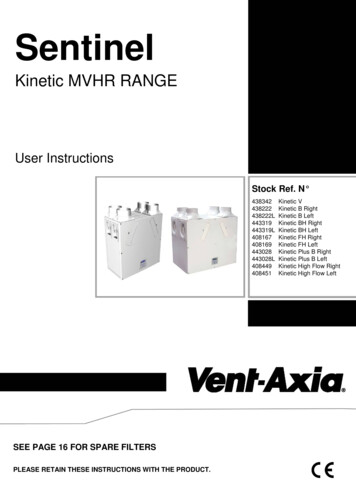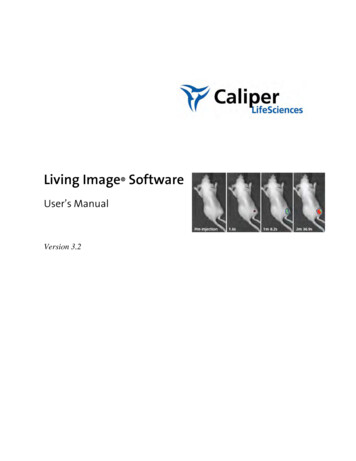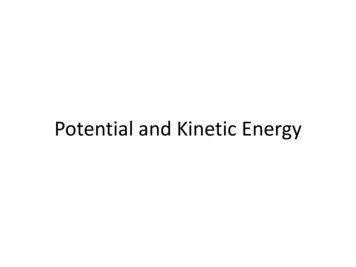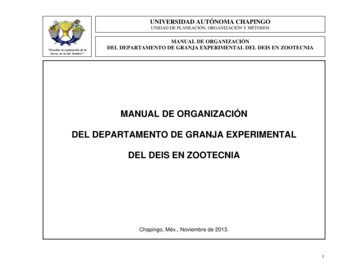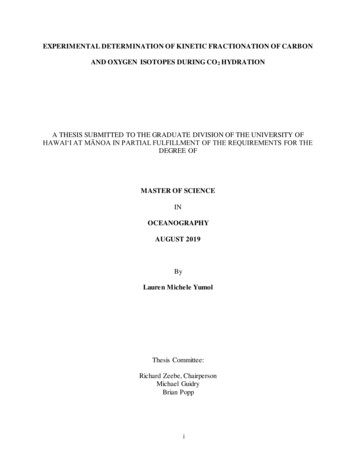
Transcription
EXPERIMENTAL DETERMINATION OF KINETIC FRACTIONATION OF CARBONAND OXYGEN ISOTOPES DURING CO 2 HYDRATIONA THESIS SUBMITTED TO THE GRADUATE DIVISION OF THE UNIVERSITY OFHAWAI‘I AT MĀNOA IN PARTIAL FULFILLMENT OF THE REQUIREMENTS FOR THEDEGREE OFMASTER OF SCIENCEINOCEANOGRAPHYAUGUST 2019ByLauren Michele YumolThesis Committee:Richard Zeebe, ChairpersonMichael GuidryBrian Poppi
ACKNOWLEDGEMENTI would like to give my utmost thanks to my thesis advisor Richard Zeebe and my co-advisorJoji Uchikawa for not only providing me with the opportunity to work on this project, but alsofor their encouragement, patience, and knowledge over the last few years which has helped shapemy scientific experience. I also appreciate the thoughtful advice both Richard and Joji providedme which gave me the motivation needed to persevere through any difficulties I encountered. Iwould like to thank my committee members, Michael Guidry and Brian Popp, for their insightand wisdom. Thank you to Dustin Harper and Colin Carney at the Stable Isotope Lab at UCSCfor analyzing my carbonate samples and for always providing a fast turnaround on results.A special thanks to the Marine Geology and Geochemistry Division faculty for all of thehelp provided both in the lab and in the classroom. I would like to thank Van Tran for her hardwork and dedication to her job, which aided my success as a graduate student. Thank you to theentire oceanography faculty and staff for providing a supportive work environment. I am gratefulthat Richard Zeebe and Joji Uchikawa were awarded the funding for this project by NSF andthankful that NSF approved their proposal, I would not be here if it weren’t for my advisor andco-advisor who work hard to secure the funding for this project.Finally, I would like to thank Jasper, my mom, dad, brother and my family and friends,who supported me throughout my entire college education and especially supportive during mygraduate school career. I am so lucky to have had support I received from these special peopleover the years.ii
ABSTRACTThe CO2 hydration reaction is a fundamental chemical transformation involved in variousphysicochemical, geochemical, and biological processes, and essential in aqueous solutions thatcontain dissolved inorganic carbon (DIC). In marine environments, the CO2 hydration reaction and its affiliated products (i.e. H2 CO3 , HCO-3 , CO23 , and H ) play a critical role in regulatingocean pH, biogenic and inorganic mineral precipitation, biological carbon fixation, carbonsequestration, and more. There is a characteristic kinetic isotope effect (KIE) that is associatedwith the CO2 hydration reaction, which causes the reaction product to be depleted in the heavyisotopes of carbon and oxygen. It is important to understand how KIEs influence carbon andoxygen isotope compositions because the isotopic compositions of substances or compounds thatform from HCO-3 (i.e. the product of CO2 hydration (CO2 H2 O)), for example carbonate mineralsused as indicators of past environments, will also be affected. Despite evidence of KIEs occurringin the environment, there are only a few experimental studies that have attempted to characterizekinetic isotope fractionation (KIF) during the hydration of CO2 , but the KIFs reported in thosestudies suggest more experimental work is needed to better define KIEs during CO2 hydration. InChapter 1, we define important terminology that will be used throughout this thesis, describe theKIEs that are associated with the CO2 hydration reaction, and explain how KIF is related toequilibrium isotope fractionation. We will also discuss the previous experimental and theoreticalstudies and the KIFs reported in those studies. The overall purpose and main objective of this studyis to produce the most reliable experimental data available today by experimentally determiningKIEs during CO2 hydration in carbon and oxygen isotopes.iii
TABLE OF CONTENTSTITLE PAGE . .iACKNOWLEDGEMENT . . .iiABSTRACT . .iiiLIST OF FIGURES . . . .viLIST OF TABLES .viiLIST OF EQUATIONS . xiCHAPTER 1. INTRODUCTION . . .11.1 The CO2 Hydration Reaction . . .11.2 Previous Studies . .31.3 Delta Notation & Isotope Fractionation Factors . 6CHAPTER 2. EXPERIMENTAL DETERMINATION OF KINETIC FRACTIONATIONOF CARBON AND OXYGEN ISOTOPES DURING CO2 HYDRATION . . . .11Abstract . . . . 111. Introduction . .132. Theory . . .182.1 Carbon Isotope Fractionation . .202.2 Oxygen Isotope Fractionation . . .213. Methods . . .233.1 Overview of the Experimental Approach . . .233.2 Experimental Setup . . .243.3 Experimental Procedures . . 253.4 Stable Isotope Analyses . .27iv
4. Results . .294.1 Isotopic Equilibrium of DIC Species in the Carbonate System .294.2 BaCO3 Data . . . .325. Discussion . . .365.1 Potential Factors Influencing Isotopic Compositions of BaCO3 . . .365.2 KIF During CO2 Hydration . . .435.2.1 Effects of CO2 Hydroxylation . . .445.2.2 Isotope Fractionation Between CO2 (g) and CO2 (aq) . .455.3 Previous Experimental and Theoretical Studies . . . .475.3.1 Comparison to KIF of McConnaughey (1989) . . . .506. Conclusions and Implications . . .53CHAPTER 3. SUMMARY .56APPENDIX . . .58REFERENCES . . . 65v
LIST OF FIGURESFig. 2.1. a) Schematic view of the experimental setup used in this study. The setup allowscontinuous transfer of internal gas through the stock solution vessel and reactor chamber in aclosed circuit by a diaphragm pump. All components are connected by flexible and gasimpermeable tubes. b) A cross-section across the gas-solution interface during the precipitation ofBaCO3, where the thin film of the bubbles produced in the reactor chamber above the frit is shownin blue. Labels (1), (2), and (3), indicate the steps that can cause isotope fractionation. (1) CO2 (g)diffuses across the thin film, (2) the hydration/hydroxylation of CO2 (aq), where an additionaloxygen (shown in red) is derived from either H2 O or OH-, and (3) BaCO3 precipitation. Step (2)is the isotope fractionation during CO2 hydration/hydroxylation that we aim to capture with thisexperimental system . . . 23Fig. 2.2. A schematic illustration of carbon and oxygen equilibrium fractionation and KIF during13CO2 hydration at 25 C, where all values are expressed in ‰. a) For carbon, the δ C value ofHCO-3 is arbitrarily set to 0‰ on the left of the axis. The 13𝜀 between HCO-3 and CO2 (g) is 8‰(blue) on the right of the axis, where the blue arrow direction indicates HCO-3 is isotopicallyheavier relative to CO2 (g), which is roughly given by the difference between -values (i.e.13131313𝜀𝐻𝐶𝑂3 𝐶𝑂2(𝑔) δ CHCO3 -δ CCO2(g)). Similarly, the difference between δ CCO2 (g) and the mean13δ CBaCO3 yields the mean 13KIF (19.6 0.25‰; red), where BaCO3 is isotopically lighter relativeto CO2 (g) (red arrow). b) For oxygen, the 18 O value of H2O is arbitrarily set to 0‰ and the 18 Oof HCO-3 instantaneously produced without fractionation from CO2 and H2 O is 27‰, calculatedfrom Eq. (2.11) (blue arrow). 18 O values that fall below 27‰ indicate KIEs. The difference1818between δ OHCO-3 (instant) and the mean δ OBaCO3 is equal to the mean 18KIF (5.3 0.55‰; red),where BaCO3 is isotopically lighter relative to HCO-3(instant) (red arrow). The 18KIF (green) is1818calculated from the difference between the δ OCO2(g) and the mean δ OBaCO3 where BaCO3 isisotopically lighter relative to CO2 (g) (green arrow) . .3113Figure 2.3. The δ C (vs. VPDB) and 18 O (vs. VSMOW) values of all 4 batches. The temperatureand pH of the experiments are discussed in detail in Section 4.2. Error-bars are based on the 2 13standard deviations for both δ C and 18 O values (see Section 3.4 for details) .35Figure 2.4. The average 13KIFs and 18KIFs at pH 9.0 from batches 1, 2, and 3 compared to theaverage 13KIF and 18KIF of Batch-4 data at pH 8.0. Each color represents the pH at which eachexperiment was conducted .42Fig. 2.5. A schematic illustration comparing mean 13KIFs and 18KIFs from Batch-4 andMcConnaughey (1989) at T 25 C and 21 C, respectively, where the scaling of the arrowsdenoting KIFs is only estimated. A) The 13KIFs of Batch-4 (left of center axis) and McConnaughey(right of center axis) in permil (‰). The 13KIF between BaCO3/ CaCO3 and equilibrium HCO-3(red arrows) were calculated from the δ 13C of BaCO3/ CaCO3 and the measured δ 13C value ofNaHCO3 for Batch-4, and the known 13𝜀𝐻𝐶𝑂3 𝐶𝑂2 reported by Emrich et al (1970) and Deines etal. (1974) for McConnaughey (green arrow). The 13KIF between BaCO3/ CaCO3 and CO2 (aq)vi
(purple arrows; *i.e. 2‰ less than if compared to CO2 (g) (magenta arrows; Mook, 1986)), whereCO2 (g) of Batch-4 was derived from Eq. (2.7) and the measured δ 13C value of NaHCO3, and theCO2 (g) from McConnaughey was directly measured. The 13KIF between CO2 (g) and CO2 (aq) (Eq.(2.17)) and the δ 13 C values for CO2 (g) from Batch-4 and McConnaughey were used to calculatethe final 13KIF between BaCO3/ CaCO3 and CO2 (aq). B) The 18KIFs of Batch-4 (left of axis) andMcConnaughey (1989) (right of axis). The line labelled δ𝐶𝑎𝐶𝑂3 on the right side of the center axisrepresents the δ 18O value of CO2 (g) liberated from CaCO3 by acid dissolution in equilibrium withVSMOW. **The acid fractionation factor between the liberated CO2 (g) and the solid CaCO3 is 10.2‰, so the true δ 18O value of McConnaughey’s solid CaCO3 is 10.2‰ lighter than δ𝐶𝑎𝐶𝑂3(black arrow), which will be the value used to calculate 18KIFs that can be directly compared to18KIFs of Batch-4. The 18KIF between BaCO and CO32 (g) (magenta arrow) was determined from18the δ O value of CO2 (g) derived from the relationship between Eq. (2.10) ( 18𝜀𝐶𝑂2 (𝑔) 𝐻2𝑂 ; lightblue arrow) and the measured δ 18O value of H2 O (-3.1‰). The same 18KIF for McConnaugheywas calculated using the measured δ 18O value of CO2 (g) used in the experiments. The 18KIF wedefined from Eq. (2.12) is given by the green arrow .50Fig. 2.6. A comparison between 13KIFs and 18KIFs of Batch-4 between CO2 (g) and BaCO3 at T 18 C (green triangles) and 25 C (red circles), and the 13KIFs and 18KIFs between CO2 (g) andCaCO3 reported by McConnaughey (1989) at T 21 C (dark blue circles) and 1.1 to 4.3 C (lightblue circles). The positive increase in 13KIFs and 18KIFs indicates stronger 13C and 18O depletionsin BaCO3 (or CaCO3) relative to equilibrium CO2 (g) 53vii
LIST OF TABLESTable 1.1/Table 2.1 The average 13KIFs and 18KIFs of CO2 hydration reported from previousexperimental and theoretical studies . . 6/17Table 2.2 Parameter descriptions of the 4 batches of experiments, including the total amount ofexperiments per batch and the time frame at which each batch was ran. The pH was measured inthe tris buffer/reactor solution 27Table 2.3 The equilibrium 13𝜀 and 18 𝜀 between the relevant CO2 (g) - DIC - H2 O species estimatedbased on the temperature dependence of the fractionation factors previously determined. The δ 13Cand δ 18O values for CO2 (g) were constrained from the calculated equilibrium ε, along with theδ 13C of NaHCO3 ( 13C -2.8‰ (VPDB)) and δ 18O of H2 O ( 18O -3.1 (VSMOW)) directlymeasured and used for the experiments. The δ 18O value of instant HCO-3 was calculated from Eq.(2.11). All ε and values are reported in ‰ and temperature are reported in C . 32Table 2.4 Batch-4 13KIF between equilibrium CO2 (g) and experimental BaCO3 and 18KIF betweeninstantaneous HCO-3 and experimental BaCO3, calculated from Eq. (2.8) and (2.12), respectively.The mean 13KIF and 18KIF at T 25 C is also reported. All Batch-4 experiments were conductedat pH 8.0. The uncertainty for the calculated KIFs represents a 2σ standard deviation. The meanuncertainties represent the standard deviation of the mean (σ m ) for Batch-4 samples atT 25 C .45Table A1. Full experimental description of batches 1-4 including sample ID, temperature, pH,δ 13C, δ 18O, and experimental notes recorded at the time of the individual experiment 62Table A2. Initial mass of Ba measured from BaCl2 2H2O crystals and final mass of precipitatedBaCO3 sample for all for batches. Moles of Ba were calculated from both the initial mass of Baand final mass of Ba then subtracted to yield the remaining moles of Ba in solution .65Table A3. Average 13KIFs and 18KIFs during CO2 hydration for batches 1-4. KIFs are organizedby temperature and pH. The value of n represents the amount of samples used to calculate theaverage KIFs at various parameters specified for each batch .67viii
LIST OF EQUATIONSCHAPTER 1 EQUATIONSEq. (1.1a):Eq. (1.1b):Eq. (1.2):12𝑘12 CO2 H2 O H12CO-3 H . . .112𝑘 13𝑘13 CO2 H2 O H13 CO-3 H . . .113𝑘 13𝐾 ′12𝐾13𝑘 ′ 𝛼 (13 𝑘 ′ Eq. (1.3): δ13 Cs (13R -13 Rsstd13R stdEq. (1.4): Aαa-b 𝐴𝑅𝑎𝐴𝑅𝑏 12𝑘) (12 𝑘 ) . . . . .2) 1000 . .71000 𝛿 𝐴Xa1000 𝛿 𝐴Xb . . .7AEq. (1.5): 𝐴ε ( αa-b 1) 103 103 ln( Aαa-b ) . . .7Eq. (1.6):12CO2 H13CO-3 13CO2 H 12 CO-3 . . .8CHAPTER 2 EQUATIONSEq. (2.1):Eq. (2.2):Eq. (2.3):12𝑘12 CO2 H2 O H 12CO-3 H . . .1312𝑘 13CO2 H2 O13𝐾 ′12𝐾13𝑘 13 H CO3 H . . .1313𝑘 13𝑘 ′ 𝛼 (13𝑘′ 12𝑘) (12 𝑘 ) . . . . . .14 . . . .18Eq. (2.4):ix
Eq. (2.5): CO2 H2 O HCO-3 H . . .18Eq. (2.6): CO2 OH- HCO-3 . . . .19Eq. (2.7):13𝜀(HCO- -CO313Eq. (2.8): KIF 2 (g)) -0.1141(Tc) 10.78‰ . .20δ13CCO 2 (g) 1000δ13CBaCO 3 1000 . . . 21Eq. (2.9): CO2 (g) H2 O 21Eq. (2.10):18𝛼(CO2 (g)-H2 O(l ))Eq. (2.11): 18 RHCO-3 Eq. (2.12):18KIF 17.604T 0.98211 . . .212 181RCO 18 RH2 O32(g) 3δ18Oinstant HCO- 10003δ18OBaCO 3 1000 . . . . 22 . . . 22Eq. (2.13): δ18 OVSMOW 1.03091 δ18 OVPDB 30.91‰ .281313Eq. (2.14): δ CCO2 (g) δ CNaHCO3 - 13αHCO - -CO32 (g)13αHCO 3-CO 2 (g)[() 1 ]100018Eq.(2.15): δ OCO2(g) [ 18αCO2 (g)-H2 O . . .30 (δ 18OH2O 1000) ] 1000 . .30Eq. (2.16): CO2 (g) CO2 (aq) . . . 45Eq. (2.17):13εCO2 (aq)-CO2(g) ( 0.0049)(T) 10.78‰ . .46Eq. (A1-a): τ-1 (0.5) {k 2 k 4 [OH-]} {1 [CO2 ]S1/2[CO ] 22 [CO2]) ( 2 ) ] } .583SS- [1 ( Eq. (A1-b): 𝑡99% ln(0.01) 𝜏 . .58Eq. (A2): 18𝜀HCO-3 -H2 O 2.59 0.00 (106 T 2 ) 1.89 0.04 .58x
CHAPTER 1. INTRODUCTION1.1 The CO2 Hydration ReactionThe hydration of carbon dioxide (CO2 ) in marine and aqueous environments is a keyreaction involved in several physicochemical, geochemical, and biochemical systems.Specifically, the CO2 hydration reaction is known for the essential role it plays in major oceanicprocesses such as ocean acidification, biological and inorganic mineral precipitation, carbonfixation, CO2 sequestration, etc. (Caldeira and Wickett, 2003; Dunsmore, 1992; Brown et al.,2009; Hopkinson et al., 2011; Stirling, 2011; Tresguerres and Hamilton, 2017). A kinetic isotopeeffect (KIE) is associated with this reaction, where the reaction product is typically depleted inthe heavy isotopes of carbon ( 13C) and oxygen ( 18O) relative to the reactant (Bigeleisen andWolfsberg, 1958; Zeebe & Wolf-Gladrow, 2001). These KIEs are expressed in chemicalreactions when reaction rates (k) of a compound containing the heavy and light isotope differ(Hayes, 2001). For example, the reaction for the CO2 hydration can be independently written intwo forms for12C and13C isotopes:12k CO2 H2 O H 12CO-3 H 12k-1213CO2 H2 O13𝑘(1.1a) 13 H CO3 H13𝑘 (1.1b)Because the reaction rate constant for CO2 hydration involvingother counterpart for13CO212CO2 ( 12𝑘 ) is greater than the( 13𝑘 ), the reaction product HCO-3 will be depleted in13C withrespect to the CO2(aq) as a result of KIE for the CO2 hydration reaction, which is given by12𝑘 /13𝑘 (also note that KIE for the reverse reaction, or HCO-3 dehydration is given by1
12𝑘 /13𝑘 ). Furthermore, KIE and the equilibrium fractionation (α) for the same chemicalreaction is related by:13𝐾 ′12𝐾13𝑘 ′ 𝛼 ( 13 𝑘′ 12𝑘) (12 𝑘 )(1.2)where 𝐾 and 𝐾′ are equilibrium constants for the reactions of12C and13C, respectively (Eq.(1.1a) and (1.1b); Zeebe and Wolf-Gladrow, 2001). Also note that the reactions (Eq. (1.1a) and(1.1b)) as well as the definition of KIE illustrated above can be analogously written for oxygenisotopes16O and18O, where KIE for CO2 hydration is given by16𝑘 /18𝑘 . Fromthis pointforward, KIE in terms of carbon and oxygen isotopes is denoted as 13KIE and 18KIE,respectively.Apparent13C and18O depletions relative to the expected thermodynamic equilibriumhave been observed for both natural and laboratory grown carbonate minerals (e.g. Coplen et al.,(1994), Daëron et al. (2019), Kim and O’Neil (2007), and Watkins et al., (2013)), which are tosome extent attributed to KIEs associated with CO2 hydration. Yet, to date, KIEs forCO2 hydration are not well constrained in terms of both carbon and oxygen isotopes, which isexemplified by the inconsistencies in the proposed magnitude of KIEs in previous experimentaland theoretical studies (Marlier and O’Leary, 1984; Clark and Lauriol, 1992; Guo, 2008; Zeebe,2014; Sade and Halevy, 2017).This study aims to experimentally constrain kinetic isotope fractionation factors (KIF; i.e.13KIFand 18KIF for carbon and oxygen, respectively) during CO2 hydration. The experimentalsetup used in this study was adapted from McConnaughey (1989) but with importantmodifications, which will be discussed in more details in Chapter 2. The results from our2
precipitation experiments will help define the magnitude of KIFs during CO2 hydration andprovide the experimental data necessary to evaluate the accuracy of theoretical calculations.1.2 Previous StudiesThere are only a few studies that attempted to determine KIEs during CO2hydration/ HCO-3 dehydration. Clark and Lauriol (1992) experimentally grew cryogenic calciteand determined13KIFand 18KIF associated with HCO-3 dehydration to be 32.0‰ and 6‰,respectively, at 0 C. Provided with the carbon and oxygen α (Zhang et al., 1995 and Beck et al.,2005) and the KIEs for HCO-3 dehydration determined by Clark and Lauriol,13KIEand 18KIEduring CO2 hydration can be calculated as 19.7‰ and 3.7‰, respectively, based on therelationship given by Eq. (1.2) (Zeebe, 2014; Sade and Halevy, 2017). However, themineralogical formation of cryogenic calcite is uncertain, so the KIEs Clark and Laurioloriginally calculated may not be characteristic of calcite but rather another type of polymorphsuch as vaterite or ikaite (Lacella et al., 2009; Sade and Halevy, 2017). In another experimentalstudy, Marlier and O’Leary (1984) developed methods to determine13KIEsduring CO2hydration and HCO-3 dehydration. For CO2 hydration, phosphoenolpyruvate (PEP) carboxylasewas used to catalyze rapid precipitation of HCO-3 to form malate. For HCO-3 dehydration, CO2degassed from buffered NaHCO3 solution by helium sweeping was trapped using liquidnitrogen. Based on subsequent isotope analyses on the resultant malate and CO2 gas, theyreported a 13KIF during CO2 hydration of 6.9‰ at 24 C. However, in a subsequent studyperformed by the same group (O’Leary et al., 1992), the 13KIF is oddly reported as 13‰, not6.9‰ with no further explanation.3
Theoretical calculations have also been employed to quantify KIEs associated with CO2hydration. Guo (2008) theoretically calculated the 18KIF during HCO-3 dehydration and reportedan18O depletion in CO2 relative to HCO-3 of 7‰ at 25 C. Sade and Halevy (2017;2018)reported a 18KIF during CO2 hydration of 16.4‰ using the relationship between 18KIF forHCO-3 dehydration reported by Guo (2008) and18𝛼from Beck et al. (2005). However, a morerecent theoretical study by Guo and Zhou (2019) reported an estimated 18KIF for the hydration ofCO2 of 4.3‰ at 25 C. Zeebe (2014) reported 13KIF and 18KIF at 25 C to be between 23 and33‰ and 13 and 15‰, respectively. These values were based on theoretical calculations whereit was assumed that the hydration of CO2 proceeds in a stepwise fashion through a HCO-3 H3 O intermediate state rather than directly to the product (H2 CO3 ), with each pathway leadingto different KIFs (for review, see Section 2 in Chapter 2 or Zeebe, 2014). However, whether ornot the CO2 hydration reaction follows a direct or stepwise pathway is still uncertain. The 18KIFsby Zeebe (2014) reported were calculated using H2 CO3 as the product of CO2 hydration andcompared the isotopic rate constants for CO2 hydration to the fractionation betweeninstantaneously produced H2 CO3 and CO2 in isotopic equilibrium with H2 O. However, Sade andHalevy (2017; 2018) separated the individual components of the equilibrium fractionation factorHCO-3 relative to CO2 and H2 O as two(i.e. CO2 and H2 O) to calculate the18KIF betweenseparate 18KIFs. The revisedreported by Sade and Halevy for HCO-3 relative to CO2 and18KIFsHCO-3 relative to H2 O is between 4.3 and 6.2‰ and 0 to 9.6‰, respectively. McConnaughey(1989) conducted calcite precipitation experiments in an attempt to replicate kinetic isotopedisequilibrium observed in biogenic carbonates. Although his experimental data at 21 Cshow 18O and1313C depletions of 5‰ and 8.3‰, respectively, relative to δ C and 18 O valuesestimated for CO2 in isotopic equilibrium with Galapagos seawater, we have concerns for the4
values derived from McConnaughey’s precipitation experiments. First, there was no control onsolution pH, such that it varied between pH 7.4 and 8.5 during CaCO3 precipitation. Controllingthe solution pH is critical because it dictates whether CO2 hydration (predominant at low pH) orCO2 hydroxylation (predominant at high pH) is the primary reaction during precipitation (seeSection 2 in Chapter 2 for details). Thus, there is a chance that McConnaughey’s (1989)experimental carbonates do not fully record the KIE associated with CO2 hydration. Second, the13C13and 18O depletions of McConnaughey’s experimental CaCO3 were scaled relative to the δ C13and 18 O value of the CO2 source gas. However, the actual δ C and 18 O values of the CO2source gas were never provided, which makes it difficult to determine the13C and18Opartitioning specific to the CO2(g)-DIC- H2 O system in his study. More details aboutMcConnaughey (1989) will be discussed further in a later section.In summary, the currently available experimental data is limited to a few studies andcarbon and oxygen KIFs reported in the current literature are inconsistent between experimentaland theoretical studies (Table 1.1). The scarcity of available data and notably large inconsistencytherein (e.g. by a factor of 5; see Table 1.1) suggest more experimental work is required inorder to determine the KIE and fully understand the CO2 hydration/dehydration mechanism.5
Table 1.1. The average 13KIFs and 18KIFs of CO2 hydration reported from previous experimental and theoreticalstudies.ReferenceClark & Lauriol (1992)Marlier & O’Leary(1984)O’Leary et al. (1992)McConnaughey (1989)Zeebe (2014)Zeebe (2014)Guo (2008)Guo & Zhou (2019)13KIFCO2 HCO 3(‰)19.718KIFCO2 HCO 3(‰)3.7*T( 025TTT138.323-33 (n 4)10-14(n 3)----513-15 (n 4)a10.5-15 (n 3 )5.2*16.44.3E*The values reevaluated by Sade and Halevy (2017 and 2018).aKIF between CO2(g) and H2CO31.3 Delta Notation & Isotope Fractionation FactorsIn stable isotope geochemistry, isotopic abundances are measured in a material or sampleand can be used as a tool to reveal underlying mechanisms involved in the formation of thematerial. Isotopic abundances are reported as the relative difference between the isotope ratio ofa sample (𝑅 𝑠) and an isotopically known reference standard (𝑅𝑠𝑡𝑑) (Urey, 1948; McKinney et al.,1950; Hayes, 2002). The isotope ratios of carbon ( 13𝑅 ) and oxygen ( 18𝑅 ) are defined as the ratioof the less abundant isotope (i.e. the isotopically heavier isotope for carbon ( 13C) and oxygen( 18O)), to the more abundant isotope,12C and13𝑅16O: 13C 12Cand18𝑅 18O 16OIsotopic abundances yield isotopic compositions of a sample(s) and are reported using the 𝛿notation. In terms of the isotopic composition of carbon in a sample, the notation is as follows:6
13δ Cs (13R - 13Rsstd13R std) 1000(1.3)where δ13 Cs is the carbon isotope composition expressed in parts per thousand (‰) of a samplerelative to the same element in a reference standard (Hayes, 2001). Carbon and oxygen isotoperatios in carbonate minerals are reported relative to the reference standard ‘Vienna Pee DeeBelemnite’ (VPDB). Oxygen stable isotopes measured in carbonate minerals relative to theVPDB scale can be converted to a δ-value on the ‘Vienna Standard Mean Ocean Water’(VSMOW) scale when necessary for calculating oxygen isotope fractionation.Offsets or variations in isotopic compositions between compounds in the same reactionsequence can arise through physical, chemical, or biological processes, resulting in isotopicfractionation. Isotope fractionation can be quantified by the equation used calculate an isotopicfractionation factor:Aαa-b 𝐴𝑅𝑎𝐴𝑅𝑏 1000 𝛿 𝐴 Xa(1.4)1000 𝛿 𝐴 Xbwhere A is the mass number of element X, and a and b are the two different phases of thereaction. An isotope fractionation factor can also be expressed in ‰:𝐴𝜀a-b ( Aαa-b 1) 103 103 ln( Aαa-b )(1.5)Isotopic fractionation is observed when a chemical phase preferentially incorporates theheavy or light isotope relative to another phase in the same reaction (Hayes, 2002; Sharp, 2007).An isotope effect refers to the physical phenomenon that occurs in certain chemical reactions and7
is observed as an isotope fractionation (Zeebe and Wolf-Gladrow, 2001; Hayes, 2002). Theseisotope effects can occur in chemical reactions that are in thermodynamic equilibrium or inkinetically driven unidirectional reactions, the difference between the two are further discussedbelow.Equilibrium isotope effects are associated with chemical reactions that are inthermodynamic equilibrium. Isotope fractionation that occurs in equilibrium reactions is causedby differences in the vibrational frequencies of different compounds containing a commonelement. The compound containing the heavier isotope (and thus a higher mass) will have alower vibrational frequency and a lower zero-point energy, than the same compound containingthe lighter isotope. The difference in zero-point energies with compounds containing either aheavy or light isotope is what leads to isotope fractionation. Thus, different compounds in achemical reaction containing a common element may have different isotope ratios specific to thecompound (Zeebe and Wolf-Gladrow, 2001). As a rule of thumb for equilibrium isotope effects,Bigeleisen (1965) stated “the heavy isotope goes preferentially to the chemical compound inwhich the element is bound most strongly”. For example, the exchange of12C and13C in theequilibrium reaction between CO2 and HCO-3 :12CO2 H13CO-3 13CO2 H12CO-3In this reaction,enriched in(1.6)1313C is bound more strongly to HCO-3 and thus, will have a δ C value that is13C relative to CO2 . Furthermore, the preferential partitioning of13C in HCO-3suggests that the difference in zero-point energies between H 12 CO-3 and H 13 CO-3 is greater thanthe difference between 12CO2 and13CO2 .8
In contrast to equilibrium isotope effects, a kinetic isotope effect is associated withreactions that are incomplete and unidirectional. As described in Section 1.1, KIEs occur whenreaction rates of a reaction involving the heavy or light isotope differ. The KIE associated withthe hydration of CO2 is an example of a normal KIE which occurs when the molecularcompound containing the lighter isotope reacts more rapidly than the heavier isotope resulting inan accumulation of the light isotope in the product (Zeebe and Wolf-Gladrow, 2001). Becausethe reaction rate of the isotope with the smaller mass is faster than that of the isotope with thelarger mass, the isotope ratio of the product will be depleted in the heavy isotope relative to theisotope ratio of the reactant.In summary, equilibrium isotope effects lead to an observable fractionation betweendifferent chemical phases that are in thermodynamic equilibrium. Most equilibrium isotopefractionation factors (denoted here as either α or ε) involving the CO2 hydration reaction are wellconstrained for carbon and oxygen from earlier theoretical and experimental studies (Vogel etal., 1970; Mook et al., 1986; Zhang et al., 1995; Brenninkmeijer et al., 1983; Beck et al., 2005).Calculating the values for ε between different phases of the CO2 hydration reaction will play acritical role in this study when calculating final KIFs and will be described with more detail in alater section. Although KIF is important as well, there is a large gap betw
and wisdom. Thank you to Dustin Harper and Colin Carney at the Stable Isotope Lab at UCSC for analyzing my carbonate samples and for always providing a fast turnaround on results. A special thanks to the Marine Geology and Geochemistry Division faculty for all of the help provided both in the lab and in the classroom.
